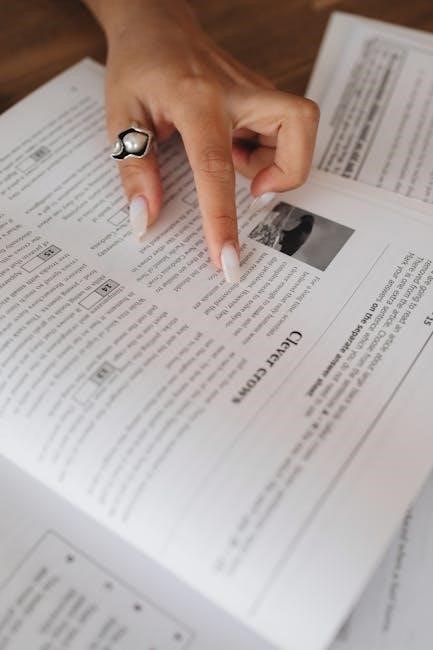Welcome to the Paraprofessional Study Guide‚ designed to help you prepare for your exam and succeed as a paraprofessional. This guide covers essential skills‚ test strategies‚ and professional responsibilities‚ ensuring you are well-equipped for both the test and your future role.
1.1 Overview of the Paraprofessional Role
A paraprofessional‚ also known as a paraeducator‚ plays a vital role in supporting teachers and students in educational settings. Their responsibilities include assisting with instruction‚ managing classroom materials‚ and providing individualized support to students‚ especially those with special needs. Paraprofessionals often handle tasks such as preparing lessons‚ supervising activities‚ and reinforcing learning concepts. They act as a bridge between teachers and students‚ ensuring a productive and inclusive learning environment. Effective communication‚ adaptability‚ and a strong understanding of educational strategies are key qualities for success in this role. This section provides a detailed overview of the paraprofessional’s duties and expectations.
1.2 Importance of the Study Guide
This study guide is an essential resource for individuals preparing to become paraprofessionals‚ offering comprehensive preparation for the certification exam and beyond. It covers key areas such as reading‚ mathematics‚ and writing‚ as well as professional responsibilities and classroom management techniques. The guide provides practical strategies‚ sample questions‚ and expert tips to build confidence and competence. By following this guide‚ aspiring paraprofessionals can ensure they are well-prepared to support teachers‚ assist students‚ and contribute effectively to educational settings. Utilizing this guide can significantly enhance readiness for both the exam and the demands of the role.
1.3 Structure of the Guide
This study guide is organized into ten comprehensive chapters‚ each focusing on key areas of knowledge and skills required for paraprofessionals. It begins with an introduction to the role and the importance of the guide‚ followed by detailed sections on test format‚ reading comprehension‚ mathematics‚ writing skills‚ and professional responsibilities. Additional chapters cover special education‚ study tips‚ common challenges‚ and final preparation strategies. Each section is designed to build upon the previous one‚ ensuring a logical flow of information. The guide also includes practice tests and exercises to reinforce learning and prepare effectively for the certification exam.

Understanding the Test Format
The test consists of 90 selected-response questions across reading‚ mathematics‚ and writing. Two-thirds focus on basic skills‚ while the remainder assess applied knowledge and problem-solving abilities.
2.1 Types of Questions
The paraprofessional exam includes various question types to assess your skills and knowledge. Most questions are selected-response‚ covering reading‚ mathematics‚ and writing. Reading questions focus on comprehension‚ main ideas‚ and vocabulary. Mathematics questions test basic arithmetic‚ algebra‚ and problem-solving. Writing questions evaluate grammar‚ sentence structure‚ and clarity. Some questions may require applying knowledge to real-life scenarios. Approximately two-thirds of the questions focus on basic skills‚ while the remainder assess applied knowledge. Understanding these question types helps you tailor your study approach and improve your test-taking strategies. Careful reading and processing of information are key to success.
2.2 Time Management Strategies
Effective time management is crucial for success on the paraprofessional exam. The test consists of 90 selected-response questions‚ and you must allocate your time wisely to answer all questions. Allocate about 60-90 seconds per question‚ depending on difficulty. Prioritize questions you understand well‚ skipping tougher ones initially and returning to them later. Practice pacing during your study sessions to build stamina and reduce anxiety. Use skimming techniques for reading passages and focus on high-value questions to maximize your score. Stay calm‚ avoid overthinking‚ and ensure you attempt every question within the allotted time.
2.3 General Test-Taking Tips
To excel on the paraprofessional exam‚ adopt strategic test-taking approaches. Always read directions and questions carefully to avoid misunderstandings. Answer easier questions first to save time for challenging ones. For reading passages‚ some experts recommend skimming the questions before reading the text to identify key points quickly. Eliminate obviously incorrect answers to increase your chances of selecting the right one. Stay calm and manage test anxiety by taking deep breaths. Ensure you attempt every question‚ as there is no penalty for incorrect answers. Practice these strategies during your preparation to build confidence and improve performance.

Reading Comprehension Skills
Enhancing reading comprehension is crucial for paraprofessionals‚ as it ensures effective communication and understanding of complex texts‚ aiding in both test success and real-world applications.
3.1 Main Idea and Supporting Details
Identifying the main idea and supporting details is crucial for effective reading comprehension. The main idea is the central theme of a passage‚ while supporting details provide evidence or explanations to reinforce it. To master this skill‚ practice active reading by summarizing paragraphs and identifying key points. Pay attention to transitional phrases that signal supporting details‚ such as “for example” or “additionally.” This technique is especially useful for paraprofessionals‚ as it enhances their ability to process and apply information quickly and accurately in educational settings. Regular practice with sample texts will improve your proficiency.
3.2 Inference and Vocabulary in Context
Inference and vocabulary in context are vital skills for paraprofessionals to master. Inference involves drawing conclusions based on clues in the text‚ rather than explicit statements. Vocabulary in context requires understanding unfamiliar words by analyzing their surroundings. Practice by identifying implied meanings and using context clues to define terms. This enhances comprehension and communication‚ essential for supporting students and teachers effectively. Regular exercises with diverse texts will strengthen these abilities‚ ensuring confidence and accuracy in both test-taking and professional environments. These skills are foundational for success in reading and applying educational materials.
3.3 Logical Sequence of Ideas
Understanding the logical sequence of ideas is crucial for effective reading comprehension. This skill involves identifying how paragraphs are structured‚ with a main idea supported by details. Practice recognizing transitional phrases like “however” or “therefore‚” which indicate shifts or connections in ideas. Additionally‚ identifying cause-effect relationships and chronological order enhances comprehension. Strengthening this skill improves your ability to process and communicate information clearly‚ which is essential for both test success and professional effectiveness in educational settings. Regular practice with various texts will help refine your ability to follow and interpret logical sequences accurately.

Mathematics Fundamentals
This section covers basic arithmetic‚ algebra‚ geometry‚ and data interpretation‚ essential for building strong problem-solving skills in mathematics.
4.1 Basic Arithmetic Operations
This section focuses on essential math skills‚ including addition‚ subtraction‚ multiplication‚ and division. Mastery of these operations is critical for problem-solving and real-world applications. Practice exercises emphasize accuracy and speed‚ ensuring confidence in fundamental calculations. Strategies include breaking down complex problems‚ using mental math techniques‚ and identifying patterns to simplify computations. Reviewing basic arithmetic ensures a strong foundation for more advanced math concepts. Flashcards and worksheets are recommended for targeted practice. Understanding these operations is vital for both the test and supporting students in classroom settings. Regular practice helps build fluency and reduces errors.
4.2 Algebra and Geometry Basics
This section covers foundational algebra and geometry concepts‚ including solving linear equations‚ understanding variables‚ and graphing functions. Geometry topics focus on properties of shapes‚ such as triangles‚ rectangles‚ and circles‚ as well as calculating perimeter‚ area‚ and volume. Practical applications are emphasized to connect math to real-world scenarios. Tips for simplifying equations and visualizing geometric problems are provided. Regular practice with sample problems and online resources can help build confidence and fluency in these areas‚ essential for both the test and supporting student learning in mathematics. Mastering these basics ensures a solid foundation for more complex math concepts.
4.3 Data Interpretation and Graphs
This section focuses on interpreting and analyzing data presented in various formats‚ such as bar graphs‚ line graphs‚ pie charts‚ and tables. You will learn to identify trends‚ compare values‚ and calculate totals or averages from the data provided. Tips for understanding scales‚ labels‚ and legends are included to improve comprehension. Practice exercises help develop skills in drawing conclusions and making predictions based on graphical information. Mastering data interpretation is crucial for both the test and supporting students in real-world math applications. Regular practice with sample graphs will enhance your proficiency.

Writing Skills and Grammar
This section focuses on improving writing abilities‚ covering grammar rules‚ sentence structure‚ and strategies for clear communication. It helps paraprofessionals convey ideas effectively.
5.1 Grammar Rules and Sentence Structure
Understanding grammar rules and sentence structure is crucial for effective communication. This section covers key areas such as parts of speech‚ verb tenses‚ subject-verb agreement‚ and punctuation. Mastering these fundamentals helps in constructing clear and grammatically correct sentences. Common mistakes‚ like run-on sentences or misplaced modifiers‚ are addressed to improve writing accuracy. Practice exercises are included to reinforce learning‚ ensuring confidence in both written and spoken communication. This foundation is essential for paraprofessionals to convey ideas clearly and professionally in educational settings.
5.2 Writing Clear and Concise Sentences
Writing clear and concise sentences is essential for effective communication. This section focuses on techniques to eliminate unnecessary words‚ use active voice‚ and ensure clarity. Avoiding overly complex structures and redundant phrases helps convey ideas more effectively. Additionally‚ organizing sentences logically improves readability. These skills are vital for paraprofessionals to communicate clearly with students‚ teachers‚ and parents. By practicing concise writing‚ you can enhance your ability to express ideas accurately and efficiently‚ both in written assignments and professional interactions. This section provides practical tips and exercises to refine your writing skills.
5.3 Avoiding Common Writing Mistakes
To enhance your writing skills‚ it’s crucial to avoid common mistakes such as grammatical errors‚ poor punctuation‚ and unclear sentence structures. Proofreading your work carefully can help identify these issues. Additionally‚ pay attention to subject-verb agreement‚ proper use of commas‚ and spelling. Avoid using overly complex language that may confuse the reader. Instead‚ focus on clarity and conciseness. Common pitfalls also include run-on sentences and misplaced modifiers. By addressing these areas‚ you can improve the overall quality of your writing and communicate your ideas more effectively. Regular practice and review are key to mastering these skills.

Paraeducator Roles and Responsibilities
Paraeducators assist teachers‚ support student learning‚ and manage classroom activities. They prepare materials‚ help with lessons‚ and ensure a positive learning environment. Confidentiality and professionalism are essential.
6.1 Supporting Teachers and Students
As a paraprofessional‚ your primary role involves supporting both teachers and students to create an effective learning environment. This includes assisting with lesson preparation‚ monitoring student progress‚ and providing individualized support to students with diverse needs. You will also help implement instructional strategies‚ manage classroom materials‚ and ensure students stay engaged. Additionally‚ you may assist with administrative tasks‚ allowing teachers to focus on instruction. Building strong communication skills and understanding student needs‚ particularly for those with special requirements like Autism Spectrum Disorders‚ is critical for success in this role.
6;2 Classroom Management Techniques
Effective classroom management is crucial for creating a productive learning environment. Paraprofessionals can support teachers by establishing clear expectations‚ using positive reinforcement‚ and encouraging respectful communication. Organizing materials and activities helps minimize disruptions‚ while active supervision ensures students stay on task. Strategies like proactive problem-solving and redirecting off-task behavior are also essential. Maintaining a structured yet flexible classroom setting promotes student engagement and reduces misbehavior. By fostering a positive atmosphere‚ paraprofessionals contribute to a focused and inclusive learning space‚ enabling students to thrive academically and socially.
6.3 Confidentiality and Professionalism
Maintaining confidentiality and professionalism is essential for paraprofessionals. Handling sensitive student and school information with discretion is crucial‚ as outlined in ethical standards and legal requirements like FERPA. Paraprofessionals must avoid sharing personal or confidential details about students‚ families‚ or colleagues. Professionalism involves being reliable‚ respectful‚ and approachable‚ fostering a positive school environment. Demonstrating initiative and maintaining appropriate boundaries ensures trust and collaboration with teachers and students. Upholding these values contributes to a respectful and efficient educational setting‚ aligning with the ethical expectations of the role.

Special Education and Exceptional Children
Understanding special education and exceptional children is vital for paraprofessionals. This section covers strategies for supporting students with diverse needs‚ including autism‚ ADHD‚ and physical disabilities‚ ensuring inclusive education and positive outcomes.
7.1 Understanding Autism Spectrum Disorders
Autism Spectrum Disorders (ASD) are neurodevelopmental conditions characterized by challenges in communication‚ social interaction‚ and repetitive behaviors. Individuals with ASD may exhibit varying levels of severity‚ from mild to severe‚ and each person’s needs are unique. Understanding ASD is crucial for paraprofessionals‚ as it enables them to provide tailored support. Key aspects include recognizing sensory sensitivities‚ communication difficulties‚ and the importance of structured routines. By fostering an inclusive environment and using strategies like visual aids and positive behavioral supports‚ paraprofessionals can help students with ASD thrive academically and socially. This section provides essential insights into diagnosing and supporting individuals with ASD.
7.2 Strategies for Inclusive Education
Inclusive education ensures all students‚ including those with autism or special needs‚ have equal access to learning opportunities. Strategies include differentiated instruction‚ visual supports‚ and flexible grouping. Assistive technologies can also enhance engagement. Paraprofessionals play a key role by collaborating with teachers to adapt materials and provide individualized support. Creating a positive classroom culture that values diversity fosters social acceptance and academic growth. By addressing diverse learning needs‚ inclusive practices empower students to reach their full potential‚ ensuring they feel valued and supported in their educational journey. These strategies promote equity and create a welcoming environment for all learners.
7.3 Behavioral Support Techniques
Behavioral support techniques are essential for paraprofessionals working with students who may exhibit challenging behaviors. Positive reinforcement‚ such as praise or rewards‚ encourages positive actions. Proactive strategies like identifying triggers and using visual aids can prevent misbehavior. Structured routines and clear expectations help students feel secure. Paraphrasing instructions and redirecting focus are effective tools. Consistency in applying these techniques is key to fostering a calm and productive learning environment. By combining empathy with proven methods‚ paraprofessionals can support students’ emotional and behavioral growth‚ ensuring they thrive academically and socially. Proper documentation of interventions aids in tracking progress and refining strategies.

Study Tips and Resources
This section provides effective study habits‚ recommended materials‚ and practice exercises to help you prepare thoroughly for the paraprofessional exam and enhance your professional skills.
8.1 Effective Study Habits
Developing consistent study habits is crucial for success. Start by creating a structured study schedule‚ dedicating specific times to each subject area. Prioritize active learning techniques‚ such as taking notes or summarizing key concepts in your own words. Use practice tests to identify weak areas and focus your efforts there. Maintain a distraction-free study environment and take regular breaks to avoid burnout. Incorporate flashcards for quick reviews of vocabulary or formulas. Regularly review and organize your materials to ensure comprehensive understanding. Stay consistent‚ and celebrate small milestones to stay motivated throughout your preparation journey.
8.2 Recommended Study Materials
To effectively prepare for the paraprofessional exam‚ utilize the official Paraprofessional Study Guide‚ which covers reading‚ mathematics‚ and writing skills. Supplement your studying with practice tests to familiarize yourself with the test format. Online resources‚ such as the Praxis Series Study Companion‚ offer additional support. For specialized topics like supporting students with autism‚ consider guides focused on inclusive education strategies. Flashcards and printable worksheets can reinforce key concepts. Ensure all materials are up-to-date to reflect current standards. Combining these resources will provide a well-rounded preparation experience‚ helping you feel confident and ready for test day.
8.3 Practice Tests and Exercises
Engaging with practice tests and exercises is crucial for effective preparation. These tools simulate real test conditions‚ helping you assess your readiness and identify areas for improvement. Utilize online resources and study guides that offer sample questions and exercises. Focus on timed practice tests to enhance time management skills. Reviewing answer explanations will clarify concepts and reduce errors. Regularly completing exercises strengthens your understanding of reading‚ mathematics‚ and writing topics. By consistently practicing‚ you’ll build confidence and develop strategies to approach challenges effectively‚ ensuring a strong performance on the actual exam.

Common Challenges and Solutions
Overcoming test anxiety‚ managing time effectively‚ and addressing knowledge gaps are common challenges. Practice relaxation techniques‚ prioritize study schedules‚ and seek additional resources to strengthen weak areas. Stay motivated.
9.1 Managing Test Anxiety
Managing test anxiety is crucial for optimal performance. Start with deep breathing exercises to calm your nerves. Prioritize tasks‚ break study sessions into manageable chunks‚ and maintain a structured study plan. Stay positive and focus on your strengths to build confidence. Regular practice and review of materials will familiarize you with the content‚ reducing nervousness. Additionally‚ ensure adequate sleep and nutrition to maintain mental clarity. Remember‚ anxiety is natural‚ but with preparation and mindset‚ you can overcome it and perform your best on test day.
9.2 Improving Weak Areas
Identifying and addressing weak areas is essential for successful test preparation. Use practice tests to pinpoint where you need improvement. Focus on those topics by reviewing relevant sections in your study guide. Break down complex concepts into simpler parts for better understanding. Regular practice with exercises will build confidence and mastery. Seek additional resources‚ such as online tutorials or study groups‚ to reinforce learning. Consistent effort and targeted practice will help you overcome challenges and perform better on the exam.
9.3 Staying Motivated During Preparation
Staying motivated during preparation requires setting realistic goals and celebrating small achievements. Create a study schedule and stick to it‚ ensuring breaks are included to avoid burnout. Remind yourself why becoming a paraprofessional is important and how it benefits students. Surround yourself with supportive individuals who encourage your efforts. Reward yourself for progress‚ no matter how minor. Stay positive and focus on the end goal—your hard work will pay off. Persistence and confidence will help you stay motivated and prepared for success.
Review key concepts‚ practice last-minute strategies‚ and stay confident. Persistence and positivity will guide you through the test. Best of luck on your journey!

10.1 Reviewing Key Concepts
Reviewing key concepts is essential to reinforce learning and ensure readiness for the test. Start by summarizing main ideas from each section‚ focusing on critical topics like reading comprehension‚ mathematics‚ and writing skills. Use self-assessment tools to identify areas needing improvement. Practice tests can help reinforce knowledge and build confidence. Focus on understanding concepts rather than memorizing facts. Allocate time to revisit challenging subjects‚ ensuring a solid grasp of foundational skills. This systematic approach will help you feel prepared and confident on test day. Regular review ensures long-term retention of essential information.
10.2 Final Tips for Test Day
On test day‚ arrive early to avoid last-minute stress. Bring required materials‚ including valid ID and writing utensils. Stay calm and manage your time wisely‚ allocating enough minutes for each section. Read instructions and questions carefully to ensure understanding. Answer easier questions first to secure points before tackling challenging ones. Avoid spending too much time on a single question—make educated guesses if necessary. Stay hydrated and energized with light snacks beforehand. Maintain a positive mindset and trust your preparation. Remember‚ this is your opportunity to showcase your skills and knowledge effectively.
10.3 Importance of Persistence and Confidence
Persistence and confidence are crucial for success in both preparation and test-taking. Consistent effort helps build familiarity with the material and strengthens problem-solving skills. Confidence boosts your ability to approach challenges calmly and make informed decisions. Trusting in your preparation and staying focused ensures you perform at your best. Remember‚ persistence fuels progress‚ and confidence unlocks potential. Together‚ they create a mindset that drives success‚ not just on test day‚ but in your future role as a paraprofessional. Stay committed‚ believe in your abilities‚ and embrace the opportunity to excel.

Leave a Reply